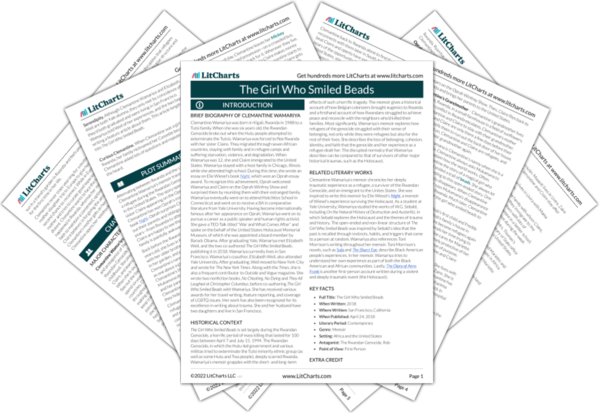The Girl Who Smiled Beads is a story about war, but it specifically focuses on what it’s like to experience and escape such violent trauma as a woman. From the moment that Clemantine and her older sister Claire flee Rwanda, they are alone as refugees for six years. Both women learn to survive starvation, homelessness, and degradation. Claire makes money however she can, dressing well and learning the local language so she can barter with other refugees and in city markets. Clemantine, on the other hand, survives in a different way: she is concerned with dignity, keeping herself and Claire’s kids, Mariette and Freddy, neat and clean so they can walk around proudly. In their different ways, both women survive harsh circumstances and maintain a sense of self.
However, much later, when she has immigrated to the United States, Clemantine reflects on the unique devastation that war brings to women: while men endure death at the hands of war, women endure the long-term effects of rape, whether literal or figurative. Clemantine explains that, for women, the Rwandan Genocide was “men…seeking to destroy [their] bod[ies] and demolish [their] future[s].” Although Clemantine survived death, she struggles to find her body beautiful again after years of degrading treatment and neglect. She believes that “silence accommodates hate” and is therefore intent on expressing her pain in order to overcome it. On the other hand, Claire focuses on moving past her trauma once she is in the United States. Similarly, Clemantine and Claire’s estranged mother—who later joins them in the United States—takes refuge in religion to ease the pain of what she’s experienced. Consequently, the solidarity between Clemantine, Claire, and their mother is undermined by the horrors they’ve faced and the tactics they’ve used to survive them. Although they share the experience, they never talk about it with one another. This shows that war uniquely disempowers women by causing them to draw on remarkable strengths to survive—strengths that, in turn, painfully alienate them from one another.
Women, War, and Survival ThemeTracker

Women, War, and Survival Quotes in The Girl Who Smiled Beads
I work every day now to erase [the] language of ruin, to destroy it and replace it with language of my own. With konona (rape, ruin), you’re told, there is no antidote, no cleansing agent. […] You’re polluted, you’re worthless—that’s it.
My body is destroyed and my body is sacred. I will not live in that story of ruin and shame.
It felt surreal and awful. I’d lost track of who I was and who we were to each other. None of us were the same people who’d lived together in that house in Kigali. Those people had died. We had all died.
My hustle was getting through the day. How to claim dignity. How to keep the kids clean […] How to “shine” the house, which was really just dousing the floor with petrol to keep out the bugs. How to wash my loud, floral, short-sleeved Hawaiian shirt, which I loved and which I wore with my jean skirt, tied at the waist. How to make the kids cute, and thus make them lovable and seen.
For that one hour, I felt proud. Not just dignified but certain, impermeable, a rock. The sun that turned the window glass into a mirror had confirmed my existence. But I needed to see my body—I needed to own it.
Almost every other minute of my existence, I felt the pain of being nobody’s child, the sting of the assumptions people make when you don’t have a mother and you don’t have a father. People assume you’re adrift, at play. They assume that you are vulnerable. They assume your needs are lesser, that your will is broken, that your body can be bent to theirs.
My body itself remained alien, a burden. I’d had to carry this thing around with me—this body with its dark skin […] this body, with its liabilities, this body that had been vandalized, stolen. This was the hardest thing in the world: to remember the ravagement and still believe my body was magic, to remember the shattering and still believe my body was spectacular, holy, and capable of creation.
Rape is the story of women and war, girls and war, hundreds of thousands of mothers, daughters, sisters, grandmothers, cousins, and aunts in my country alone, hundreds of millions across the world. So many men were murdered in the massacre. So many women later died of HIV. Rape, ruin—corporeal, psychological, social—lingered in even the most polished, sophisticated, private spaces decades after the war.
Every time I need to summon my toughest, most self-actualized persona, I channel [Claire]. […] But […] my most generous feelings [towards Claire] are clouded by my own need to be recognized.
[…]
These days, when I’m with Claire, we have so much love and so much fear, and we want to kill each other.











